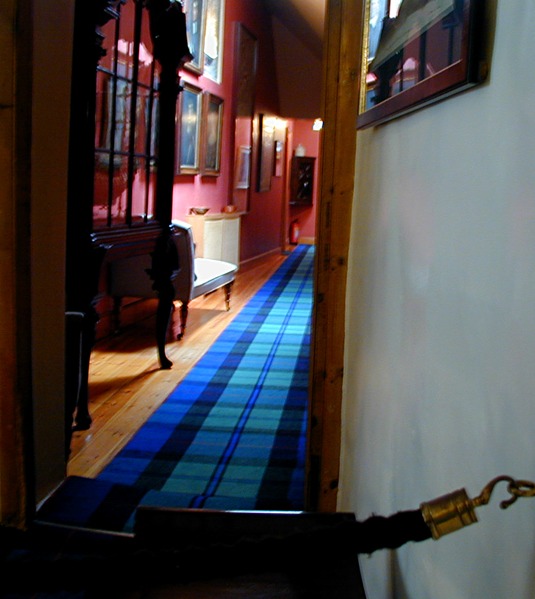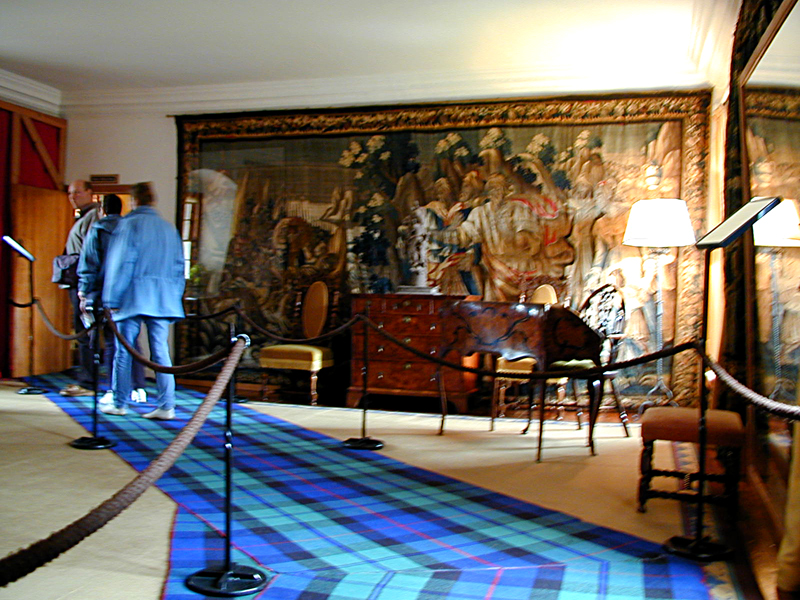Hi Mairiuna!
It was truly a pleasure to read your post “The Wonderful Colors of Scotland: Blue…” , so much, it inspired me to gain more insights about blue tartans!
The first thing that came to my mind was the blue tartan rug layed upon the corridors leading us through oddly-angled rooms and appartements when we visited the mysterious Cawdor Castle, which dates back to the late 14th century.
Remember these photographs? I bet you do. 🙂
Cawdor Castle is set amid gardens in the parish of Cawdor, approximately 10 miles (16 km) east of Inverness and 5 miles (8.0 km) southwest of Nairn in Scotland. The castle is built around a 15th-century tower house, with substantial additions in later centuries. Originally a property of the Clan Calder, it passed to the Campbells in the 16th century. It remains in Campbell ownership, and is now home to the Dowager Countess Cawdor, stepmother of Colin Campbell, 7th Earl Cawdor.
The castle is perhaps best known for its literary connection to William Shakespeare’s tragedy Macbeth, in which the title character is made “Thane of Cawdor“. However, the story is highly fictionalised, and the castle itself, which is never directly referred to in Macbeth, was built many years after the life of the 11th-century King Macbeth.
Source: Wikipedia
” (…) This expansive corner of Scotland is known simply as Cawdor. It is an 80-square-mile estate that has belonged to the Thanes of Cawdor and their family since the 13th century. Today, the property is in the nurturing hands of the seventh Earl of Cawdor and 25th Thane, Colin, and his wife, Isabella, who moved into the valley shortly after they married in 1994.
Since then, they have transformed what was once a lonely and slightly neglected place into a magical and lively spot (…) The cottage has now been expanded to become the family’s nine-bedroom house. Drynachan Lodge, which was built in 1820 and added to over the next 100 years, is about 1,000 yards up the valley from Carnoch, and is where shooting parties stay.
But perhaps the most charming lodging is a tree house that Colin built for their four children (Jean, 14, James, 13, Eleanor, 11, and Beatrice, 7) amongst a clutch of alder trees on the riverbank.
The trees grow through the house, which is built entirely from reclaimed windows and doors found in cottages on the estate, and the roof is tiled in Canadian cedar shingles, giving it an almost Mad Hatter–ish look.
Colin, who trained as an architect, built it between 2003 and 2005. At the time, he was commuting to London during the week to work at Odey Asset Management as an analyst. The tree house was a way for him to reconnect to the land and his young family.
In 2006, he left finance to give his full attention to the estate. “I loved Odey, I absolutely loved it, but I succumbed to the siren call of the highlands,” says Colin. (…)
“What they have managed to do in this ancient, timeless place is to make it present in a way that means it is actually possible to dive into the landscape and actively take a part in it—the river up to your hip, the heather bouncing you about the hill, the practical wilderness in your own hand,” says Scottish actress Tilda Swinton, the Cawdors’ friend and neighbor.
So many estates have had to look at very public ways of bringing in revenue to keep them afloat: concerts, festivals, even zoos. The glorious thing about Cawdor is that the family has simply capitalized on what they have always had and run it along very traditional lines. Today, there is a young spirit to the land, which teems with youthful keepers and their families. With sheep roaming on the moor, partridges flying in vast skies overhead and shots heard in the distance from time to time, the landscape has changed little in its 800 years. The couple have been wise to choose the Drynachan Valley as their home, their children growing up in this idyllic place, contributing to its regeneration. “Colin and Isabella’s curatorship of that land is a profound achievement,” Swinton says. “There is magic in that valley. It’s impossible not to taste it.”
Source: In the land of Macbeth
To learn more about this impressive and renowned castle, I recently bought the book written by Liza Campbell, A Charmed Life; Growing up in Macbeth’s Castle, the last child to be born in the castle.
Her father Hugh, 25th Thane of Cawdor, sunking into madness with self-destructive behavior took her from an idyllic fairytale childhood to a nightmare.
I find it very courageous on her part to have written this memoir…
Liza Campbell (born 24 September 1959 as Lady Elizabeth Campbell), is an artist, calligrapher, columnist and writer, born in the north of Scotland and currently living in London, England.
She is the second daughter of Hugh Campbell, 6th Earl Cawdor (1932–1993) by his first wife, the former Cathryn Hinde and the last child of an Earl Cawdor to have been born at Cawdor Castle, which has previously been erroneously associated with Shakespeare’s Macbeth. (Her older sister Lady Emma Campbell was also born there, but her brothers and younger sister were born elsewhere, as were the children of the present Earl.)
Campbell was raised in Cawdor Castle during the Sixties, and studied art at Chelsea. She lived in Mauritius, Kenya (Nairobi) and in Indonesia between 1990 and 1996.
As an artist, Liza Campbell worked in an art gallery, and has had exhibitions of engraved soapstone at All Saints Gallery, Babbington House and the Sladmore Gallery. More recently, she has shown collages at the Michael Naimski Gallery.
For four years, from 2000, she wrote a back page column Adventures of a Past It Girl.
Campbell was the second of five children, and the second daughter of three daughters. Her parents divorced in 1979 after 22 years of marriage.
In 1990, she married William Robert Charles “Willie” Athill, a big-game fisherman, with whom she lived on a desert island for two years. By that marriage, she has two children, a daughter Storm (b. 1990) and a son Atticus (b. 1992).She is now divorced from Athill, the marriage having broken down in 1993.
Source: Wikipedia
But I digress here. Let’s get back to the tartans!
Ancient and modern Scottish tartans are a very interesting subject to explore and below are some books we like to recommend as they are part of Scotiana’s library.
Campbell of Cawdor Tartan
One can find these books and much more on Amazon.com See below for featured items.
Enjoy!
Until next, all the best.
Janice – Scotiana Team












Hello
Here Jan Peetam from Holland
I would like to know what this blue tartan Rug is called and where I can order it…I hope you can help me
Hello Jan, Thank you so much for reaching out and expressing your interest in the blue tartan rug featured in our blog post about Cawdor Castle.
Unfortunately, I must share that we don’t have the specific details on the name of this blue tartan pattern or where it can be directly ordered.
You might consider contacting tartan manufacturers or retailers in Scotland, as they often have extensive catalogs of tartan patterns and might be able to identify the pattern for you. We hope these suggestions are helpful.
Best wishes in your search.
Janice – Scotiana Blog Team